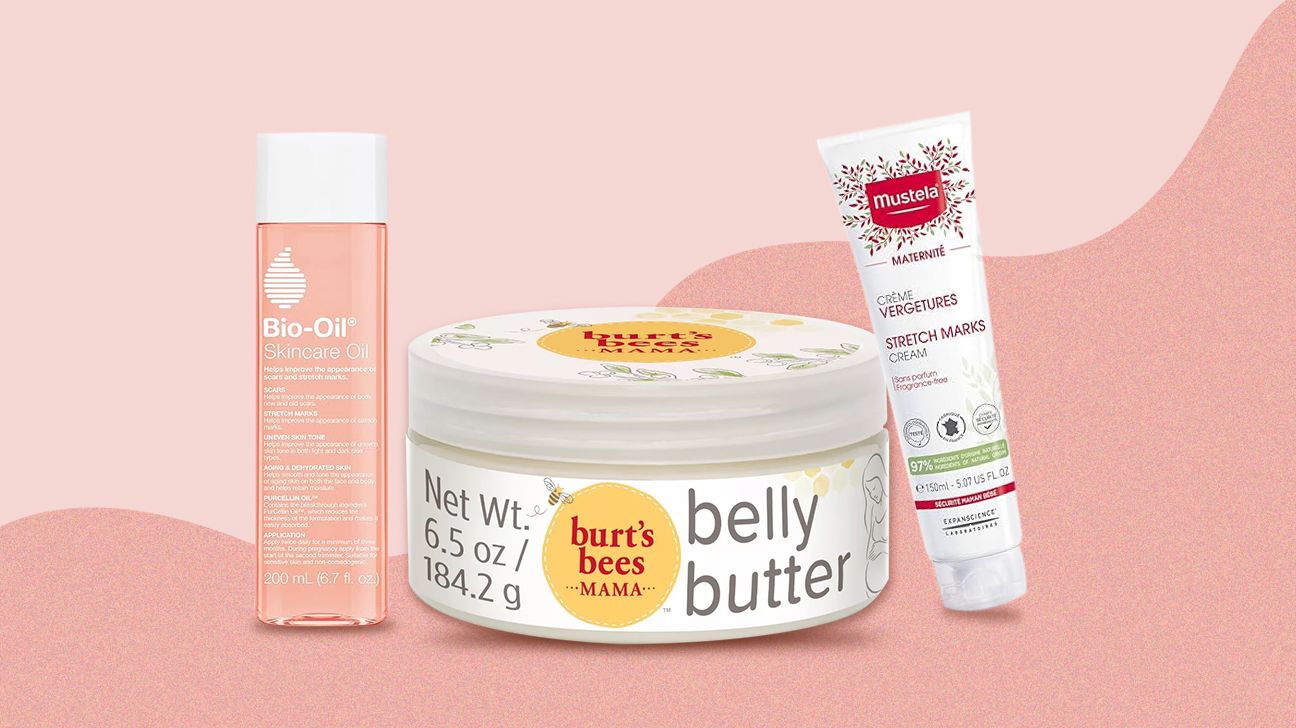Any lotion, oil, or cream can be used to help prevent stretch marks, but after talking with moms and dermatologists, we chose some favorites.
There really isn’t a miracle stretch mark cream for pregnancy that’s proven to prevent them. “A cream that has evidence-based medicine behind it — we don’t have that,” said Dr. DiAnne Davis, FAAD, a dermatologist at Texas Health Presbyterian Hospital in Dallas.
But even if there isn’t sound evidence to suggest they’re preventable, it’s also not a bad idea to stay moisturized as your body grows and changes.
What we do know for sure is that keeping your skin moisturized as it expands helps support fragile skin and encourage circulation. It can help your skin look and feel better and maybe help prevent stretch marks from forming.
There are several products available labeled as stretch mark creams or belly oils, but in reality, any body lotion, oil, cream, or butter that’s made with pregnancy-safe ingredients works just fine. If you’re looking for suggestions, here are some that we recommend.
Pricing guide
- $ = under $10
- $$ = $10 to $20
- $$$ = over $20
• shea butter
• cocoa butter
• mango butter
• vitamins
• fatty acids
• seed extracts
• vitamin E oil
• sunflower oil
• lavender oil
• calendula
• vitamin E
• squalane
• jojoba butter
• cocoa seed butter
• shea butter
• vitamin E
• sunflower seed oil
• shea butter
• jojoba butter
• cocoa seed butter
The market is full of stretch mark creams that promise amazing results. While there’s no clinical evidence to suggest stretch marks are totally preventable, there’s also no harm in trying.
To select the products above, we searched through ingredient lists and product reviews to help you narrow down your search. We chose the best stretch mark creams for pregnancy based on the following criteria:
- Experience: We considered feedback from nine moms about eight different products they purchased and tried throughout their pregnancies.
- Ingredients: We looked for stretch mark creams formulated with hydrating ingredients, like nut butters and oils — such as cocoa, shea, or jojoba.
- Brand integrity: We sought trusted brands that are leaders in their industry. They all passed our vetting process, which ensures brands follow ethical business standards and don’t have any pending lawsuits, among other factors.
- Price: There’s no need to break the bank for a stretch mark cream. We tried to feature stretch mark creams that fall between $8 and $30 — though we did recommend one option that’s a splurge.
- Reviews: We combed through online customer reviews, only featuring the brands that were well liked and easy to use and alleviated customers’ skin issues.
- Experts: We reached out to board certified dermatologists to get their opinion on what makes for the best stretch mark creams.
Decide whether you want a cream that is scented or fragrance-free. Scan the ingredients list for potential irritants, especially if you have allergies or sensitivities. While pregnant and nursing, avoid products that contain retinoids.
Choose a product — or investigate creating your own — that contains ingredients like:
- nut butters such as cocoa, shea, jojoba oil, like Mustela Stretch Marks Cream
- vitamins A and E, like Bio-Oil Skincare Oil
- hyaluronic acid
- coconut, argan, or rosehip oil, like Burt’s Bees Mama Bee Belly Butter
- aloe vera, like Earth Mama Belly Butter
- peptides, like Mustela Stretch Marks Cream
“Certain ingredients that can sometimes be helpful are hyaluronic acid or peptides,” Davis said. “I usually will check active ingredients and recommend the patient check with their OB-GYN before using it.”
During pregnancy, stretch marks can develop on your breasts, belly, hips, butt, and thighs.
Retinoids can help with treating stretch marks postpartum. “They help to restore the skin’s collagen,” Davis said.
But it may be best to avoid retinoids while you’re pregnant. They’re most likely safe while breastfeeding — with topical application only — but that research is limited.
Oral use of retinoid-containing treatments aren’t recommended during lactation. Davis also recommends in-office stretch mark treatments, such as microneedling or laser treatments.
You don’t have to wait until you start noticing marks. Many creams work as a preventive measure, so it can be helpful to use one as soon as you find out you’re pregnant.
You can use the cream throughout each trimester and even after you give birth. Davis recommends using the cream every day after you take a bath or shower.
You can try making it part of an indulgent self-care routine, which may include self-massage, exfoliation, or a good old-fashioned bubble bath.
Stretch mark creams won’t make old stretch marks completely go away. However, depending on the cream you use, it may somewhat reduce the appearance of the marks.
In addition to using a stretch mark cream, eating a nutritious, well-balanced diet, drinking enough water, getting regular exercise, and gently massaging your belly every day may help prevent or reduce stretch marks during pregnancy.
Talk with your midwife or doctor about gaining baby weight at a slow and steady pace and to make sure you’re not deficient in any vitamins.
There’s not enough evidence to suggest that coconut oil can prevent or treat stretch marks. However, many skin experts are a fan of the ingredient.
Garshick notes that because coconut oil works to moisturize and may calm inflammation, it may help improve the overall appearance of your skin.
There’s a lot going on in your body and mind right now. Go ahead and pamper yourself with one of these stretch mark creams. Best case scenario, it prevents stretch marks. Worst case scenario, you’re left with really soft, hydrated skin.





